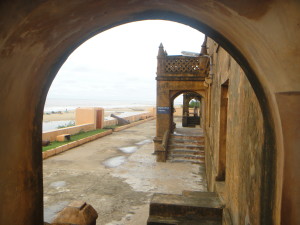
 In August 1618, when the first Danish ship Oresund sailed to Indian waters, captain Ove Gidde would not have thought it will be the beginning of a two century-long relationship of his country with India. During that disastrous journey, he lost most of his crew members and finally took refuge at the court of Tanjore King Ragunatha Nayak. Through a treaty with the king he got Taragambadi, a village around 20 km from Nagappattinam, for an annual rent of Rs 3111 and built a ware house, Fort Dansborg. It later became a flourishing Danish settlement on the Coromandel coast till 1845 when it was finally sold over to the British.
In August 1618, when the first Danish ship Oresund sailed to Indian waters, captain Ove Gidde would not have thought it will be the beginning of a two century-long relationship of his country with India. During that disastrous journey, he lost most of his crew members and finally took refuge at the court of Tanjore King Ragunatha Nayak. Through a treaty with the king he got Taragambadi, a village around 20 km from Nagappattinam, for an annual rent of Rs 3111 and built a ware house, Fort Dansborg. It later became a flourishing Danish settlement on the Coromandel coast till 1845 when it was finally sold over to the British.
After years of neglect, Dannebrog (Danish national flag) fluttered along with Indian tricolor over the fort again on July 14, 2002 when it was renovated with help of a Danish NGO.
Though the written history of the town begins with Danish settlers, Tamil epic Silappadikaram mentions it as ‘Kulashekharapattinam’. Later it became Sarangapadi, the land of singing waves.
Though Tranquebar is now considered as an ideal place for a retreat, the town still preserves the charm of an old Scandinavian town with its centuries-old colonial buildings. Most of the streets here still carry their Danish names keeping its link with the colonial past.
Dansborg Fort, built in1620 remains to be the major attraction with its Danish military architecture and a museum showcasing the memorabilia of the colonial history dating back to 17th century. For more than two centuries, Tranqubar served as one of the busiest trading centre of exporting spices and textile from India to Europe. In return gold and silver coins piled up at the courts of many Indian kings. Recently, a group of marine archaeologists dived into the sea here again and found wrecks of several ships on the sea bed.
Enter the town through the historic Land Gate built by Danish settlers in 1792. The heritage town welcomes you to Kongensgade (King’s street) which leads up to the shore with many colonial era buildings lined up on either side of the street.
Many buildings still keep their thick stucco walls, massive pillars and verandahs taking back the visitors to the busy Danish trading centre once thrived here.
Though most buildings have been converted to schools and offices of Christian missionaries, New Jerusalm Church and Zion Church retains its Danish architectural beauty even after 200 years. Governor’s Bulgalow has now been converted into a heritage hotel which helps the visitors to have magnificent view of the sea from its terrace. Next to it is the Masilamani Nathar temple built by a pandya king in 1305, receiving the waves almost inside the sanctum sanctorum. Ravaged by the tsunami in 2004, the temple has now been completely renovated.
Left to the king’s street is Queen Street which houses the Tranquebar Maritime Museum, a private-run museum opened in 2010. The post Tsunami rehabilitation works has moved away the fishermen huts to a safer place away from the cost. Paying tribute to the victims of tsunami, this museum has kept the tools and equipment traditionally used by fishermen. A huge ‘Selling’ traditionally called masula boat has been preserved here. The last Selling was lost during the 2004 tsunami and no other museums in the world, except here has kept an original selling today, said 64-year-old care taker J Krishnamurthy.
Tags: Danish ship, Dannebrog, Footprints, Fort Dansborg, Kongensgade, Land Gate, New Jerusalm Church, Ove Gidde
Hey mate! I just stumbled up on your website and all I can say is that it’s a very nice one. Lots of usefull information written in a nice way, just how I like it. I did notice one problem that I used to experience on my own blogs. It’s your search engine rankings. Don’t panic tho, I installed this lovely SEO WP plugin: bit-ly/13M1q53 (replace – with .) on my WordPress site and ever since have been gaining rankings and with that loads of visitors.